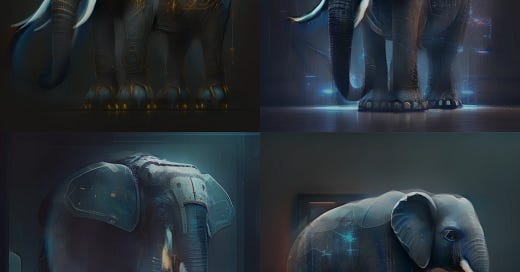[58] Memes and the Elephant in a Dark Room
GM Readers!
This week we explore Memes. Many mistake memes for just funny images on the internet, but they are much more than that. Memes play a critical role in adoption of emerging technologies like Web3. Memes represent stories, ideas, values, etc that are easily shareable and simple enough to understand.
Let’s unpack!
Building Blocks:
🎨 Life in Color Relevant Essays: [Stories the OG Human Innovation], [Web3 as a Movement]
Additional Readings: What is a Meme(NTY); Emojis (NYT); Meme (Wikipedia)
Memes are critical to help drive the adoption of emerging technology.
Memes at heart are ideas, stories, concepts and culture … often depicted visually through symbols.
Technology answers: Can it work?
Can the internet work?
Can blockchain work?
Can AI work?
Memes answer: Do we want it to work?
🤔👇
What is a meme?
From Wikipedia:
A meme is an idea, behavior, or style that spreads by means of imitation from person to person within a culture and often carries symbolic meaning representing a particular phenomenon or theme
A meme acts as a unit for carrying cultural ideas, symbols, or practices, that can be transmitted from one mind to another through writing, speech, gestures, rituals, or other imitable phenomena with a mimicked theme.
But wait… aren’t memes just jokes on the Internet?
Richard Dawkins coined the term in his book the The Selfish Gene (launched in 1976): “We need a name for the new replicator, a noun that conveys the idea of a unit of cultural transmission, or a unit of imitation.”
While memes are a large part of Internet culture, they are more than just an internet thing. Humans have used memes to communicate for as long as they have used any symbolic system.
Through visual depiction / symbols, memes capture ideas and spread ideas.
Memes are building blocks for culture, movements, ideas and stories. They represent and symbolize an ideology into something visual and shareable.
Why are Memes Important?

In the above Tweet, the “intersubjective and imaginary things” (aka stories) that we believe in underpin all of human society.
Stories are ideas.
Everything in our world is just a story: the joke we all resonate with, the concept of money, the way the world is organized… literally everything is a story.
Our entire society is built through stories. Humans tell stories and we organize around those stories.
Stories are the OG human innovation.
Stories exhibit network effects: The more people that buy into a story, the more staying power it has. At some tipping point, enough people believe in the story that we stop questioning the story (especially if it transcends across generations).
The story becomes fact. It becomes a fundamental truth.
Memes are important because they make stories and the ideas behind those stories relatable in a simple and compact way. They are good at expressing complex ideas / emotions in a way that is easily digestible and recognizable — often as an image / symbol.
Remember simple is hard.
And with the marginal cost of distributing information on the internet being virtually zero, memes can spread at scale on the internet.
Memes Across History
Memes are not a new concept, they have existed throughout history in some form.
Let’s look at some examples from Web -1 (negative one): hieroglyphics and logos.
Hieroglyphics
Visual language is as old as civilization itself.
The Egyptians used hieroglyphics as their formal writing system in Ancient Egypt. Hieroglyphics convey complex ideas and stories through the use of symbolism.
Some might argue that hieroglyphics were inefficient and are just some ancient thing … but thousands of years later we are still using symbols to communicate. Most signage in the modern world uses pictograms: symbols that conveys its meaning through its pictorial resemblance to a physical object.
On the Internet and in the digital era, we use emojis, where the primary function of an emoji is to fill in emotional cues otherwise missing from typed conversation

For example: if you wanted to say “thank you,” you could send one of these emojis: 🙏
Logos
I can write you a long essay on Nike’s logo / brand and explain what it stands for.
Or I can just show you this.
Most people will have a shared feeling about what the Nike Checkmark represents because of the strength of Nike’s logo.
They’ll see the Nike Checkmark and remember its slogan: Just Do It ✔
Those who recognize the logo will immediately associate this logo with a variety of things: concepts, emotions, values, ideals, etc.
Great logos don’t necessarily talk about the product, they speak about the ideals behind the product — the intangibles the product represents.
When we see the Nike logo, we don’t think about the utility of the shoes, we think about being a champion or being a part of a club of champions.
Great logos are memes — they are symbols that represent a story, ideal, or value. They evoke the emotions that an endless amount of words try to convey.
A picture is worth a thousands words (or more).
Web3: Elephant in a Dark Room
All emerging technology suffer from an adoption problem … that’s why they are “emerging.” 🤔😏 (I will use Web3 as the example here, since that’s what I know).
The Elephant in a Dark Room metaphor can be used to describe the state of Web3 adoption. There are variations of this story, but the version I like goes like this…
There is an elephant in a dark room. Different people try to describe the elephant by touching it. But each person is touching a different part of the elephant, so each person calls it something different (it’s a tree, a mouse, a chair, etc).
In Web3, everyone is trying to define what Web3 is from their vantage point. Some people talk about how great the technology is. Others talk about how they can make money. Then there are some who believe there is only one implementation of Web3 that works. Etc etc.
From outside of Web3, this ends up looking like a bunch of people in the same industry speaking different languages, arguing and defending why their argument is the right one.
The point of this story is that no one is wrong, their subjective experience is true … but it’s not the whole truth.
Fundamentally this is a framing problem — we don’t have a unifying story for Why Web3, for those not in Web3.
Emerging Technology Adoption
My framework on adoption of emerging technology looks something like this:
Philosophy / Stories / Values: helps us get to “we want this”
Enablers (technology, education, etc): helps us get to “we can do this”
Applications / Use Cases: helps us get to “we realize utility from this”
We need all 3 to enable mass adoption.
Mass adoption is about convincing the “average user” (middle of the bell curve) to cross the chasm, in the easiest way possible.
For emerging technologies, if there isn’t an easy entry point, it doesn’t really matter how good the technology and the products are. The story / ideology needs to be powerful but simple enough for the average person to overcome natural inertia and switching costs. Once they become interested they are more likely to learn more about the technology, etc.
This doesn’t mean the technology isn’t important. Of course the technology is important, but it may not be the entry point for most.
Web3 Adoption: Framing
In Web3, we tend to explain why Web3 is better than Web2, by focusing on the the technology — blockchain technology will change the world in x, y, z ways and here is how blockchain will get us there…
The problem with arguing this way is that it’s a losing battle for Web3 from the start. Web2 has been around for a while and has had decades of compounding network effects across its products, technologies and user experiences. For the average user outside of Web3, Web2 is better.
Web2 and Web3 definitions box people into a narrow view of what the tech actually is … the “first principles approach” is a better evaluation framework: what does the tech allow you to accomplish?
- Jack Butcher, Artist behind Checks VV
The average user doesn’t fully understand the magic of blockchain technology. They probably also don’t care about the technology as much as you want them to.
So for the average user looking from outside in, there is nothing they can latch onto for “Why Web3.”
This is where stories come in.
What’s the story for this emerging technology? Why do we want this?
For artists like Jack Butcher and many in Web3, it’s👇
The image on the left is the Bitcoin Whitepaper, which started the Web3 movement.
By now, the people who saw the technology as an entry point have probably already entered the space.
Will the “average user” (who isn’t currently in this space) onboard into the space by starting on the left?
Unlikely, because:
they may not be technical enough to read it and appreciate all of its details
inevitably across 9 pages of a whitepaper, they will find details to disagree with
it’s too much detail for the “average user” and assumes the average user cares about the technology
This is where the image on the right comes in.
The image on the right is an NFT launched by Punk 6529 as part of their broader Meme Card Series.


The “Freedom to Transact” image is more approachable and is easier for the “average person” to ponder and explore. It does a better job of capturing attention.
Remember how the iPod was introduced? 1,000 songs in your pocket


We live in a world where we vote with our attention. Attention is our most prized currency.
An image / symbol that represents the philosophy, stories, ideology and values behind an emerging technology opens up new pathways for people to explore emerging technologies.
For Web3, we need a collective story. Maybe it’s “Freedom to Transact.”
But until we get our story straight, we’ll never see the elephant in the dark room.







